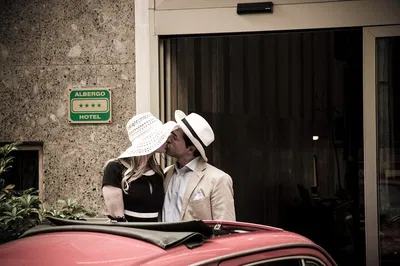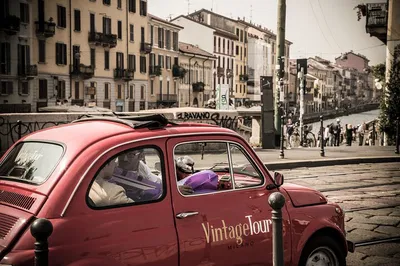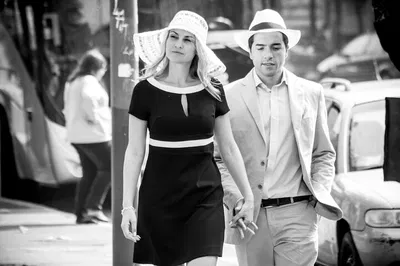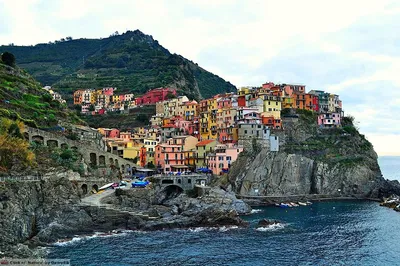Milan Vintage Fiat 500 Tour: Explore Like a Local!
240
Overview
The 4 hour Vintage Fiat 500 Grand Tour in Milan is the best way to see the whole city! This tour takes people through Milan's cool spots in a classic Italian car.
Imagine riding in a red Fiat 500, stopping at famous places like the Duomo of Milan (Milan Cathedral) and the Navigli District. See Villa Belgiojoso Bonaparte, State Archives of Milan, Porta Nuova (Medieval), Brera District, Sforzesco Castle and many more. The tour leader will drive and guide, so everyone can enjoy the ride and learn about the city.
This tour shows off Milan's old and new areas. It drives through the historic center, the canal-filled Navigli, the modern CityLife District, and the Garibaldi area. This adventure includes four stops where everyone can walk around and take in the sights.




Highlights
See Milan in Style: Ride in a classic red Fiat 500 for a unique tour.
Visit Top Spots: Stop at four famous places to explore Milan.
Expert Driver: A tour leader drives and tells about the city.
All of Milan: From old streets to new buildings, see it all.
Sentiment Analysis
People love seeing Milan in a classic Fiat 500 with friendly guides. The tour is fun and shows off the city, but some wish for seatbelts.

Customers really enjoyed riding around Milan in the cute, vintage Fiat 500.
The tour guides are friendly and know a lot about Milan.
Many people said this tour is a fun and different way to see the city.
The stops at famous places let people explore and take great pictures.
Some people wish the Fiat 500 had seat belts for safety.
A few customers mentioned the cars can be a bit noisy.
The Journey
Villa Belgiojoso Bonaparte
The Villa Belgiojoso Bonaparte, also known as the Royal Villa of Milan, is a neoclassical masterpiece nestled in front of the Giardini Montanelli. Constructed between 1790 and 1796 by Leopoldo Pollack, it showcases an exquisite English-style garden. Today, it houses the Modern Art Gallery, offering a delightful blend of architectural elegance and artistic treasures. A perfect spot for art lovers and those seeking a tranquil escape.
State Archives of Milan
Located in the historic Palazzo del Senato, the State Archives of Milan safeguard invaluable documents from state and public bodies, as well as private collections. Delve into the city's rich history through meticulously preserved records, offering a glimpse into Milan's administrative and cultural evolution. A must-visit for historians and researchers seeking primary source material.
Porta Nuova (Medieval)
The Medieval Porta Nuova represents a significant historical gate within Milan's ancient walls. As one of the largest gates of the medieval layout, it offers a tangible connection to the city's fortified past. Walking through its arches is like stepping back in time, providing a unique perspective on Milan's evolution from a medieval stronghold to a modern metropolis.
Brera District
The elegant Brera district is a vibrant hub of art, culture, and luxury. Explore the renowned Art Gallery, wander through the serene Botanical Garden, and admire the Church of Santa Maria del Carmine. Indulge in high-end shopping and savor exquisite cuisine at elegant bars and restaurants. Don't miss the Leonardo da Vinci-designed lock at the end of Via San Marco, a testament to the genius that shaped Milan.
Sforzesco Castle
The Sforzesco Castle is an imposing fortress located just outside Milan's historic center. Built in the 15th century by Francesco Sforza on the remains of a 14th-century fortification, it stands as a symbol of Milanese power and resilience. Explore its vast courtyards, museums, and art collections, including Michelangelo's unfinished Rondanini Pietà. A captivating journey through Milan's ducal history.
Santa Maria delle Grazie
The Basilica of Santa Maria delle Grazie, a UNESCO World Heritage site, is a Renaissance masterpiece in the heart of Milan. Home to Leonardo da Vinci's iconic 'Last Supper,' it represents the pinnacle of human creative genius. Witness the awe-inspiring fresco and immerse yourself in the artistic and spiritual atmosphere of this extraordinary landmark. A pilgrimage for art enthusiasts and history buffs alike.
San Maurizio al Monastero Maggiore
The Church of San Maurizio al Monastero Maggiore, often called the 'Sistine Chapel of Milan,' boasts an architectural structure and a stunning decorative cycle from the Leonardesque school. Admire the vibrant frescoes and intricate details that adorn its walls, offering a glimpse into the artistic fervor of the Renaissance. A hidden gem showcasing Milan's rich artistic heritage.
L.O.V.E. Sculpture (The Finger)
L.O.V.E., an acronym for Freedom, Hate, Vengeance, Eternity, is a provocative sculpture by Maurizio Cattelan, commonly known as 'The Finger.' Located in front of the Palazzo della Borsa (Stock Exchange), this bold artwork sparks conversation and challenges perceptions. A contemporary landmark that reflects Milan's embrace of modern art and its willingness to confront societal norms.
Piazza Cordusio
Once the financial heart of Milan, Piazza Cordusio has transformed into a vibrant social and commercial hub. Though financial institutions have relocated to newer skyscrapers, the square retains its historical charm. Explore its elegant architecture, bustling atmosphere, and diverse shops and cafes. A central meeting point that reflects Milan's ever-evolving identity.
Duomo of Milan
The Duomo of Milan, officially the Metropolitan Cathedral of the Nativity of the Blessed Virgin Mary, is an iconic symbol of the city and an Italian national monument. Located in the heart of Milan, this magnificent Gothic cathedral took nearly six centuries to build. Marvel at its intricate façade, ascend to the rooftop for panoramic views, and immerse yourself in the spiritual grandeur of this architectural masterpiece.
Via Torino
Via Torino is one of Milan's oldest streets, renowned for its long-standing commercial tradition. As an important connecting road between Piazza Duomo and the Navigli area, it offers a delightful mix of shops, boutiques, and historic buildings. Stroll along this bustling thoroughfare, soak in the vibrant atmosphere, and discover the essence of Milanese commerce.
Basilica of San Lorenzo
Dating back to the 4th century, the Basilica of San Lorenzo stands as a testament to Milan's ancient past. Once located outside the city walls, near the amphitheater and imperial palace, it was a prominent landmark for those entering Milan. Admire its Roman columns, Byzantine mosaics, and the tranquil atmosphere that contrasts with the city's modern bustle. A journey through centuries of history.
San Bernardino alle Ossa
The Church of San Bernardino alle Ossa, located in Piazza Santo Stefano, is renowned for its unique ossuary chapel. In the 17th century, its walls were adorned with human bones, creating macabre baroque decorations. An unusual and thought-provoking site, offering a glimpse into the city's historical approach to mortality and remembrance.
Via Laghetto
Via Laghetto derives its name from the small lake of Santo Stefano, which played a crucial role in the construction of the Milan Cathedral. In the late 1300s, this waterway facilitated the transport of Candoglia marble, reducing costs and expediting the Duomo's construction. A reminder of the ingenuity and logistical efforts that shaped Milan's most iconic landmark.
University of Milan (La Statale)
Founded in 1923, the University of Milan, colloquially known as 'La Statale,' is a prestigious public university. Its main campus is housed in the Renaissance building of 'Ca' Granda,' originally commissioned as the city's hospital. Wander through its historic courtyards, admire the architectural details, and experience the academic atmosphere of one of Italy's leading educational institutions.
Courthouse
Built between 1932 and 1940 in the twentieth-century style, the Milan Courthouse is a notable architectural landmark. Its construction required the demolition of the Church of San Filippo Neri in Bovisasca and the Convent of the Slaves of Mary, reflecting the city's evolving urban landscape. A significant example of rationalist architecture in Milan.
Rotonda della Besana
The Rotonda della Besana is a late Baroque cemetery complex, featuring a long, closed portico surrounding the former Church of San Michele ai Nuovi Sepolcri. Built starting in 1695, based on a design by Arrisio Arrigoni, it now houses the MU.BA (children's museum). A peaceful oasis that blends historical architecture with contemporary cultural experiences.
Porta Romana
Porta Romana is one of Milan's six main gates, built along the former Spanish walls. A monumental arch from 1596, commissioned by Philip III of Spain, stands at the center of Piazza Medaglie d'Oro. Explore this historical gateway, a symbol of Milan's past fortifications and its connection to Spanish influence.
Navigli District
The Navigli of Milan, a network of canals, once facilitated navigation across the region, connecting the large lakes to the sea. Instrumental in transporting materials for the construction of the Milan Cathedral, the Navigli district now thrives with restaurants and cafes. Stroll along the canals, admire the historic architecture, and experience the vibrant nightlife of this unique neighborhood, shaped by Leonardo da Vinci's hydraulic engineering innovations.
San Vittore Prison
The San Vittore Prison, inaugurated in 1879, is a penitentiary institution located along Viale Papiniano. Its imposing structure reflects the architectural style of the late 19th century. The adjacent Viale Papiniano hosts a bustling open-air market, creating a unique juxtaposition of confinement and everyday life.
Teatro Nazionale
The Teatro Nazionale, designed by Mario Borgato, began as a movie theater before being inaugurated as a theater in 1924. The square it occupies also boasts the city's first 'skyscrapers' (only 38 meters high!), designed in Art Deco style by the same architect in 1923. A historical site blending performance arts with architectural innovation.
CityLife District
Milan's CityLife district showcases a modern urban landscape with luxury apartment buildings and cutting-edge office skyscrapers. The CityLife Shopping District offers trendy shops, international restaurants, and a cinema. Explore the expansive CityLife park, with its lush meadows, pedestrian paths, and cycle routes. Visit the Palazzo delle Scintille, a venue for fashion shows and exhibitions. A testament to Milan's contemporary vision.
Maspes-Vigorelli Velodrome
The Maspes-Vigorelli Velodrome, built in 1935, is a historic sports facility in Milan. Originally dedicated to track cycling, it is now primarily used for American football. A preserved landmark of sporting history, offering a glimpse into Milan's athletic heritage.
Arco della Pace (Porta Sempione)
The Neoclassical Arco della Pace (or Porta Sempione, 1807) was the first of Milan's five newest gates, built along the Spanish ramparts, now demolished. It was conceived as a triumphal entrance to the city from France, located in the large square behind the Piazza d'Armi of the Sforzesco Castle. A symbol of peace and triumph, reflecting Milan's historical ties to European powers.
Gianni Brera Civic Arena
The Gianni Brera Civic Arena, inaugurated in 1807 as the Milan Amphitheater, is a multifunctional sports facility. Acquired by the Municipality in 1870, it became the Civic Arena. A historical landmark for sports and events, reflecting Milan's enduring passion for athletic pursuits.
Monumental Cemetery of Milan
The Monumental Cemetery, designed by Carlo Maciachini and opened in 1866, is an open-air museum showcasing Milan's history through its elaborate tombs and monuments. Spot the final resting places of influential figures whose names adorn metro stations, roads, and squares. A captivating journey through Milan's past, commemorating its notable citizens.
Rainbow Tower
Built in 1990, the Rainbow Tower is a colorful homage to Milanese creativity, transforming an anonymous water tank in Porta Garibaldi. Restored for Expo2015, it stands as a vibrant symbol of the city's artistic spirit and its ability to revitalize urban spaces. A quirky landmark celebrating Milan's design and innovation.
UniCredit Tower Complex
The UniCredit Tower complex consists of eco-sustainable buildings in glass and steel, designed by Cesar Pelli. Comprising three towers of varying heights, the tallest reaches 230 meters. This modern architectural marvel dominates Milan's skyline, symbolizing the city's financial prowess and commitment to sustainability. A futuristic landmark showcasing Milan's dynamic growth.
Bosco Verticale (Vertical Forest)
The Bosco Verticale is an innovative complex of two residential tower buildings designed by Boeri Studio, located on the edge of the Isola district. Covered in thousands of trees and plants, these 'vertical forests' promote biodiversity and improve air quality. A groundbreaking example of sustainable urban design, showcasing Milan's commitment to green spaces.
Diamond Tower (Diamantone)
The Diamond Tower, also known as Diamantone, is a striking skyscraper in Milan's business center. Currently the headquarters of the Italian companies of the BNP Paribas Group, its distinctive diamond-shaped design makes it a prominent feature of the city's skyline. A symbol of modern architecture and financial strength.
Milan Central Station
Milan Central Station, a monumental railway station, was inaugurated in 1931. Built from a project started in 1911, its construction was revived under Mussolini's regime. The station stands as an architectural masterpiece and a historical site, bearing witness to both grandeur and tragedy, including the deportation of people to concentration camps during World War II. A poignant landmark that embodies Milan's complex history.
Rasini Tower
The Rasini Tower, designed by Emilio Lancia and Gio Ponti, is a historic building in Milan, used as luxury apartments. Built in twentieth-century style, the complex is located on the corner between Corso Venezia and Porta Venezia. Its unique design, comprised of both the Tower and the Palace, makes it a significant example of Milanese architecture.
Palazzo Buonarroti-Carpaccio-Giotto
The Palazzo Buonarroti-Carpaccio-Giotto is distinguished by the large passage arch created by Piero Portaluppi, giving it a strong architectural character. A landmark example of Portaluppi's architectural style in the city.
Palazzo Serbelloni
Palazzo Serbelloni, a splendid example of neoclassical architecture, takes its name from the Serbelloni family. Built in the second half of the 18th century by Simone Cantoni, this majestic palace exudes elegance and grandeur. A historical landmark that reflects the aristocratic heritage of Milan.
Milan Cathedral (Duomo)
The Milan Cathedral, one of the largest Catholic churches in the world, is a masterpiece of Gothic architecture. Built on the site of previous basilicas, its construction began in 1386 and continued for centuries. Dedicated to Santa Maria Nascente, this iconic symbol of Milan dominates the city's skyline and embodies the city's artistic and spiritual heritage. A must-see destination for visitors from around the globe.
Palazzo Litta
Palazzo Litta, also known as Palazzo Arese Borromeo Visconti Litta, is a historic building located in Corso Magenta. A prime example of Milanese Baroque architecture, it currently houses regional offices of the Ministry of Cultural Heritage and Activities and Tourism. Admire its ornate façade, intricate details, and rich artistic legacy. A cultural treasure showcasing Milan's Baroque splendor.
Know Before You Go
This fun tour includes a classic red Fiat 500 and a driver who is also the tour guide. There are 4 stops where you can walk around and see the sights. This tour does not have coffee, tea, air conditioning, restrooms, or Wi-Fi. Also, the Fiat 500s do not have seat belts or air bags.
Hot Tip
To make the most of the tour, wear comfortable shoes for walking during the stops. Remember to bring a camera to capture all the beautiful sights!





